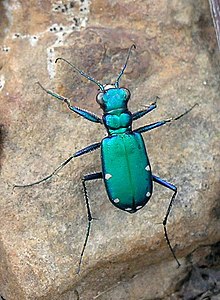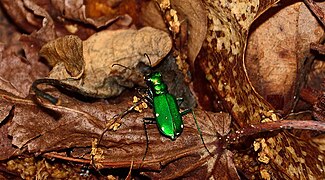Cicindela sexguttata
| Cicindela sexguttata | |
|---|---|
 | |
Conservation status | |
| Scientific classification | |
| Domain: | Eukaryota |
| Kingdom: | Animalia |
| Phylum: | Arthropoda |
| Class: | Insecta |
| Order: | Coleoptera |
| Family: | Cicindelidae |
| Genus: | Cicindela |
| Species: | C. sexguttata |
| Binomial name | |
| Cicindela sexguttata Fabricius, 1775 | |
The six-spotted tiger beetle, also known as the six-spotted green tiger beetle (Cicindela sexguttata), is a common North American species of tiger beetle in the Cicindelinae subfamily. It is common in many areas of the states, and is well known. It is recognized for its bright green color and its flight pattern. The beetle is largely harmless to humans and may live as long as three years.[citation needed]
Description
They are commonly found in deciduous forests in between Minnesota,[2] southeastern Canada[1] and south to eastern Texas,[3] excluding the Florida Panhandle,[1] and are easily recognizable by their large, white, overlapping mandibles. The adult is 12–14 mm (1/2-5/8") in length,[4][page needed] and has fairly long legs. The mandibles give these attractive insects a ferocious appearance. While tiger beetles are voracious predators of small arthropods, they do not bite humans unless handled. Both the common name and the species name refer to the six small white spots on the beetle's metallic-green to metallic-blue-green elytra. This is not always the case, however, as some individuals may have more spots,[5] fewer spots, or none at all, presumably due to genetic variation. This species is associated with wooded areas and they are often found in sunlit patches clear of undergrowth such as dirt paths and fallen logs where they hunt caterpillars, ants, spiders, and many other kinds of arthropods. Although tiger beetles are not gregarious, many beetles may sometimes be seen in one suitable hunting area. The female lays her eggs in sandy patches, and the larvae burrow into the ground after they hatch. Here they lie in wait until small arthropods pass by, at which time the larvae lunge out of their burrows at their prey. The beetles develop as larvae for about one year before pupating, and the insect has a total lifespan of just under five years.[citation needed]
Gallery
-
 Adult
Adult -
 Adult
Adult -
 Adult, Belleplain State Forest, New Jersey
Adult, Belleplain State Forest, New Jersey
References
- ^ a b c NatureServe (2 February 2024). "Cicindela sexguttata". NatureServe Network Biodiversity Location Data accessed through NatureServe Explorer. Arlington, Virginia: NatureServe. Retrieved 13 February 2024.
- ^ Val Cervenka (November–December 2013). "Beetlemania!". DNR. Minnesota Conservation Volunteer: 61.
- ^ Quinn, Mike (19 July 2008). "Six-spotted Tiger Beetle". Texas Beetle Information. Texas Entomology. Retrieved 13 February 2024.
- ^ Milne, Lorus; Milne, Margery (1996). National Audubon Society Field Guide to North American Insects & Spiders. Visual Key by Susan Rayfield. Alfred A. Knopf. ISBN 0-394-50763-0.
- ^ "UW-Milwaukee: Field Station - Bug of the Week: Tiger Beetles". UW-Milwaukee: Field Station. Retrieved 16 July 2019.
External links
 Media related to Cicindela sexguttata at Wikimedia Commons
Media related to Cicindela sexguttata at Wikimedia Commons Data related to Cicindela sexguttata at Wikispecies
Data related to Cicindela sexguttata at Wikispecies- Cicindela sexguttata, BugGuide
- Cicindela sexguttata, Tiger Beetle of Connecticut
- Cicindela sexguttata, Tiger Beetles of Ontario
- Tiger Beetles, Canadian Biodiversity Web Site
- v
- t
- e
- Kingdom: Animalia
- Phylum: Arthropoda
- Class: Insecta
- Subclass: Pterygota
- Infraclass: Neoptera
- Superorder: Holometabola
Suborder Archostemata | |
|---|---|
|
Suborder Adephaga | |||
|---|---|---|---|
| |||
Suborder Myxophaga | |
|---|---|
|
Suborder Polyphaga | |||||||||||||||||||||||||||||||||||||||||||||||||
|---|---|---|---|---|---|---|---|---|---|---|---|---|---|---|---|---|---|---|---|---|---|---|---|---|---|---|---|---|---|---|---|---|---|---|---|---|---|---|---|---|---|---|---|---|---|---|---|---|---|
| |||||||||||||||||||||||||||||||||||||||||||||||||















